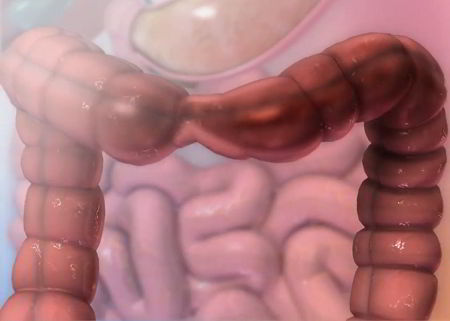Intestinal Obstruction: Overview
Alternative names: Intestinal Blockage
Intestinal obstruction (bowel obstruction) involves disruption of the normal movement of fecal matter through the bowel.
- learn what you should be doing right now
- have a doctor review your case (optional)
- identify any nutritional deficiencies
Most of the 6-8 liters of fluid that enter the small bowel each day is absorbed through the microvilli in the small intestine. The walls of the small and large bowel contain layers of smooth muscle that propel their contents forward using a series of muscle contractions called peristalsis. The nerve supply to this smooth muscle is from both the parasympathetic (vagus nerve) and sympathetic divisions of the autonomic nervous system. Parasympathetic stimulation increases movement (motility) through the gut using waves of peristalsis. Sympathetic activity has the opposite effect: it brings about a reduction in intestinal motility and peristalsis.
Signs and Symptoms

When intestinal obstruction occurs, peristalsis is either severely reduced or absent. As a result, fluid, gas and intestinal contents accumulate and abdominal distention with nausea and vomiting occurs. This leads to fluid loss, dehydration and electrolyte imbalances involving sodium, potassium and chloride. These disturbances contribute further to the existing intestinal obstruction.
Diagnosis and Tests
Laboratory findings:
- Leukocytosis – counts < 15,000/ul suggest simple obstruction; counts > 15,000/ul suggest impaired circulation; counts > 25,000/ul suggest infarction. Leukocytosis may not occur in older, debilitated patients or in those using corticosteroids or other immunosuppressive drugs.
- Leukopenia with left shift suggests infarction with sepsis.
- Increased serum amylase indicates bowel infarction, secondary pancreatitis, and leakage of pancreatic amylase into the peritoneum and bloodstream.
- Decreased pH and C02 content (metabolic acidosis) reflect lactic acidosis occurring with bowel infarction
- Increased pH and C02 content (metabolic alkalosis) secondary to vomiting with loss of fluid, H+, C1 and K
- Increased BUN suggests dehydration, blood in the intestine, or renal damage.
- Increased LDH (all isoenzymes) suggests infarction of the intestine.
- Decreased serum K and C1 secondary to vomiting
- Ascitic fluid – infarction is suggested by bloody fluid, fetid odor, bacteria, elevated amylase
- Gastric contents – presence of blood suggests infarction of the small intestine
- Rectal contents – presence of blood is common due to bleeding from infarcted bowel
Laboratory Findings of Dehydration:
- Decreased urine volume occurs early
- Increased hemoglobin and hematocrit
- Increased urine specific gravity
- Increased BUN
Complications
Distention of the bowel wall brings about an increase in capillary permeability, and intestinal fluid and electrolytes leak into the peritoneal cavity, causing peritonitis. Peritonitis is a major cause of paralytic ileus and together with fluid loss and electrolyte disturbances rapidly places the patient – unless treated correctly – into a state of hypovolemic shock.
On This Page
Intestinal Obstruction:Signs, symptoms & indicators of Intestinal Obstruction:
Symptoms - Abdomen
Symptoms - Bowel Movements
Symptoms - Gas-Int - General
Click to see sample report
Your body is a highly complex, interconnected system. Instead of guessing at what might be wrong, let us help you discover what is really going on inside your body based on the many clues it is giving.
Our multiple symptom checker provides in-depth health analysis by The Analyst™ with full explanations, recommendations and (optionally) doctors available for case review and answering your specific questions.
KEY








